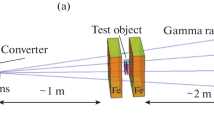Abstract
Models for characterization of laser-accelerated electron in the non-relativistic regime via its produced bremsstrahlung are provided for both thin and thick targets. An effective temperature functional is proposed to overcome the so-called cold and hot “temperatures” in the emission spectra, which are shown not to describe the underlying electron energy distribution. In contrast, this functional allows for identifying the real effect of a hot electron component. A false “heating” effect due to added noise is also exposed. The models are shown to be in good agreement with Monte Carlo simulations, as well as with other analysis methods when applied to experimental data, both in the tens of keV range.







Similar content being viewed by others
References
G. Malka, J. Miquel, Experimental confirmation of ponderomotive-force electrons produced by an ultrarelativistic laser pulse on a solid target. Phys. Rev. Lett. 77(1), 75 (1996)
B. Bezzerides, R. Jones, D. Forslund, Plasma Mechanism for Ultraviolet Harmonic Radiation Due to Intense C O 2 Light. Phys. Rev. Lett. 49(3), 202 (1982)
A.G. Mordovanakis, P.E. Masson-Laborde, J. Easter, K. Popov, B. Hou, G. Mourou et al., Temperature scaling of hot electrons produced by a tightly focused relativistic-intensity laser at 0.5 kHz repetition rate. Appl. Phys. Lett. 96(7), 071109 (2010)
K. Estabrook, W.L. Kruer, Properties of resonantly heated electron distributions. Phys. Rev. Lett. 40(1), 42 (1978)
S. Wilks, W. Kruer, Absorption of ultrashort laser pulses by solid targets and overdense plasmas. IEEE J. Quantum Electron. 33, 1954–1968 (1997)
A.S. Radunsky, I.A. Walmsley, S.P. Gorza, P. Wasylczyk, Compact spectral shearing interferometer for ultrashort pulse characterization. Opt. Lett. 32(2), 181–183 (2007)
R. Loetzsch, A. Lübcke, F. Zamponi, T. Kämpfer, I. Uschmann, E. Förster, Time-resolved X-ray diffraction of cryogenic samples using a laser based plasma source. In: Short Wavelength Laboratory Sources. Royal Society of Chemistry. pp. 398–406 (2014)
S. Fourmaux, S. Corde, K. T. Phuoc, P. Lassonde, G. Lebrun, S. Payeur, et al, Single shot phase contrast imaging using laser-produced Betatron X-ray beams. Opt. Lett. 36(13), 2426–2428 (2011). http://ol.osa.org/abstract.cfm?URI=ol-36-13-2426
F. Dorchies, A. Lévy, C. Goyon, P. Combis, D. Descamps, C. Fourment et al., Unraveling the solid-liquid-vapor phase transition dynamics at the atomic level with ultrafast X-ray absorption near-edge spectroscopy. Phys. Rev. Lett. 107(24), 245006 (2011)
F. Albert, A. Thomas, S. Mangles, S. Banerjee, S. Corde, A. Flacco et al., Laser wakefield accelerator based light sources: potential applications and requirements. Plasma Phys. Controlled Fusion 56(8), 084015 (2014)
Liu W, Wacker D, Gati C, Han GW, James D, Wang D, et al. Serial femtosecond crystallography of G protein–coupled receptors. Science 342(6165), 1521–1524 (2013). http://science.sciencemag.org/content/342/6165/1521
C. Zulick, B. Hou, F. Dollar, A. Maksimchuk, J. Nees, A. G. R. Thomas, et al., High resolution bremsstrahlung and fast electron characterization in ultrafast intense laser–solid interactions. N. J. Phys. 15(12), 123038 (2013). http://stacks.iop.org/1367-2630/15/i=12/a=123038
D. Batani, R. R. Freeman, S. Baton, The transport of relativistic, laser-produced electrons in matter—Part 1. In: K. Yamanouchi, S. L. Chin, Agostini P, Ferrante G, editors. Progress in Ultrafast Laser Science III. Springer (2010)
J. Galy, M. Maučec, D. J. Hamilton, R. Edwards, J. Magill, Bremsstrahlung production with high-intensity laser matter interactions and applications. N. J. Phys. 9(2), 23 (2007). http://stacks.iop.org/1367-2630/9/i=2/a=023
F. B. Hildebrand, Introduction to numerical analysis. Courier Corporation (1987)
M. Berger, J. Coursey, M. Zucker, J. Chang, Stopping-power and range tables, [Online]. http://www.nist.gov/pml/data/star/. National Institute of Standards and Technology, Gaithersburg, MD (2009)
S. Buffechoux, J. Psikal, M. Nakatsutsumi, L. Romagnani, A. Andreev, K. Zeil et al., Hot electrons transverse refluxing in ultraintense laser-solid interactions. Phys. Rev. Lett. 105, 015005 (2010)
D.J.S. Findlay, Analytic representation of bremsstrahlung spectra from thick radiators as a function of photon energy and angle. Nucl. Instrum. Methods Phys. Res., Sect. A 276(3), 598–601 (1989)
S.M. Seltzer, M.J. Berger, Bremsstrahlung energy spectra from electrons with kinetic energy 1 keV–10 GeV incident on screened nuclei and orbital electrons of neutral atoms with Z= 1–100. At. Data Nucl. Data Tables 35(3), 345–418 (1986)
F. W. J. Olver, D. W. Lozier, R. F. Boisvert, C. W. Clark, editors. NIST Handbook of Mathematical Functions. New York, NY: Cambridge University Press (2010). Print companion to Ref. [21]
NIST Digital Library of Mathematical Functions. Online companion to Ref. [20]. Release 1.0.11 of 2016-06-08. http://dlmf.nist.gov/
E. B. Podgoršak. Radiation physics for medical physicists. Springer (2010)
H.A. Kramers, XCIII. On the theory of X-ray absorption and of the continuous X-ray spectrum. Lond. Edinburgh Dublin Philos. Mag. J. Sci. 46(275), 836–871 (1923)
G. Hernández, F. Fernández, A model of tungsten anode X-ray spectra. Med. Phys. 43(8), 4655–4664 (2016)
G. Hernández, F. Fernández. xpecgen: a program to calculate X-ray spectra generated in tungsten anodes. J. Open Source Softw. (2016)
T.T. Böhlen, F. Cerutti, M.P.W. Chin, A. Fassò, A. Ferrari, P.G. Ortega et al., The FLUKA code: developments and challenges for high energy and medical applications. Nucl. Data Sheets 120, 211–214 (2014)
A. Ferrari, P. R. Sala, A. Fassò, J. Ranft, FLUKA: a multi-particle transport code. Geneva: CERN (2005). http://cds.cern.ch/record/898301
C. Fonseca, Generación de electrones y rayos X a partir de pulsos láser de GW y alta tasa de repetición, y su protección radiológica [PhD dissertation] (2011)
C. Fonseca, C. Méndez, C. Ruiz, F. Fernández, L. Roso, Measurement of radiation produced by ultra short laser pulses interacting with solid targets. AIP Conf. Proc. 1231(1), 223–224 (2010)
Acknowledgements
One of the authors (G. H.) gratefully acknowledges the Consejería de Educación de la Junta de Castilla y León and the European Social Fund for financial support.
Author information
Authors and Affiliations
Corresponding author
Electronic supplementary material
Below is the link to the electronic supplementary material.
Rights and permissions
About this article
Cite this article
Hernández, G., Fernández, F. Diagnostic of electron temperature from bremsstrahlung in overdense targets. Appl. Phys. B 124, 135 (2018). https://doi.org/10.1007/s00340-018-6999-5
Received:
Accepted:
Published:
DOI: https://doi.org/10.1007/s00340-018-6999-5




